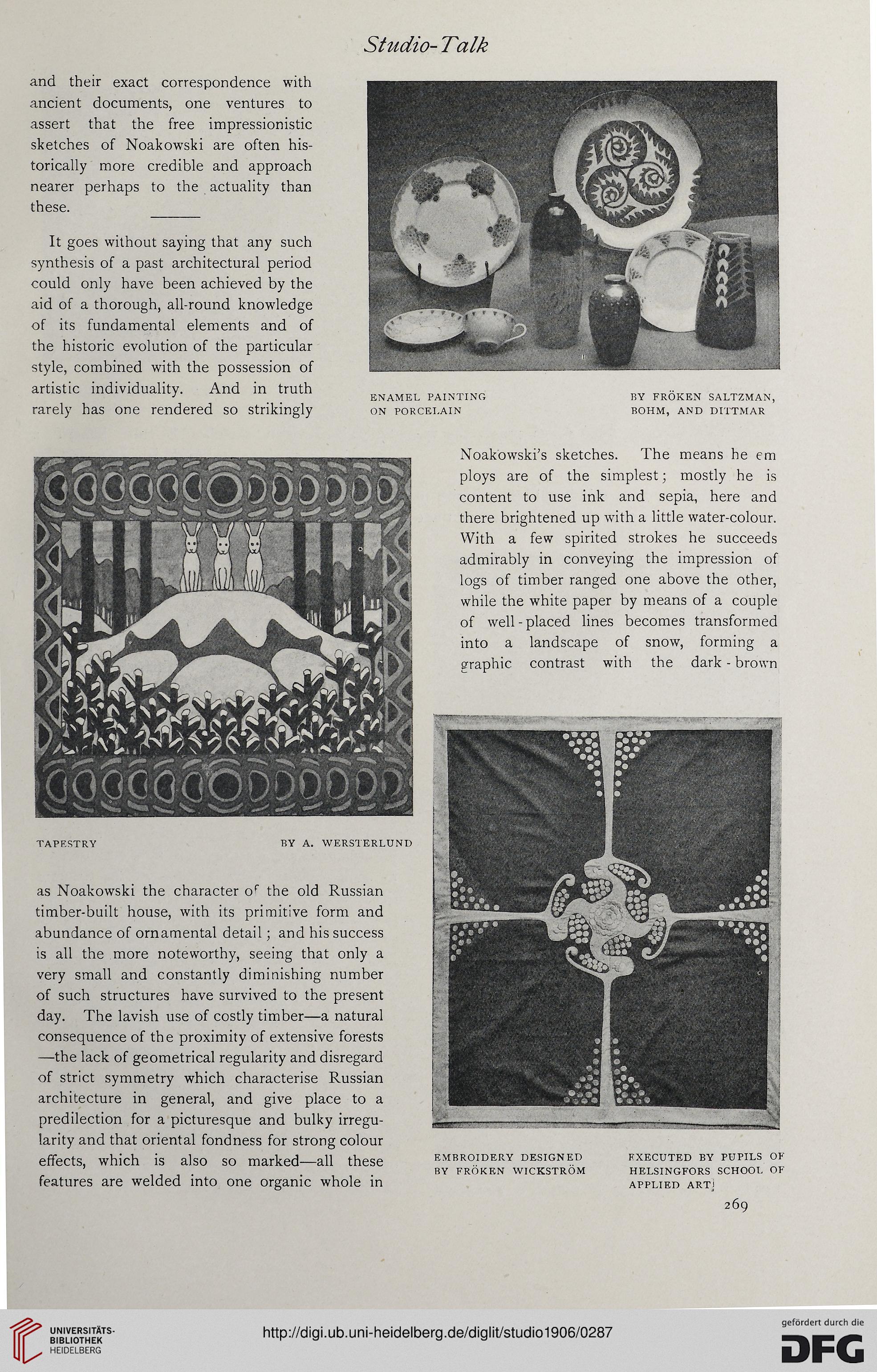Studio-Talk
and their exact correspondence with
ancient documents, one ventures to
assert that the free impressionistic
sketches of Noakowski are often his-
torically more credible and approach
nearer perhaps to the actuality than
these.
It goes without saying that any such
synthesis of a past architectural period
could only have been achieved by the
aid of a thorough, all-round knowledge
of its fundamental elements and of
the historic evolution of the particular
style, combined with the possession of
artistic individuality. And in truth
rarely has one rendered so strikingly
ENAMEL PAINTING BY FROKEN SALTZMAN,
ON PORCELAIN BOHM, AND DITTMAR
TAPESTRY BY A. WERSTERLUND
as Noakowski the character of the old Russian
timber-built house, with its primitive form and
abundance of ornamental detail; and his success
is all the more noteworthy, seeing that only a
very small and constantly diminishing number
of such structures have survived to the present
day. The lavish use of costly timber—a natural
consequence of the proximity of extensive forests
—the lack of geometrical regularity and disregard
of strict symmetry which characterise Russian
architecture in general, and give place to a
predilection for a picturesque and bulky irregu-
larity and that oriental fondness for strong colour
effects, which is also so marked—all these
features are welded into one organic whole in
Noakowski’s sketches. The means he em
ploys are of the simplest; mostly he is
content to use ink and sepia, here and
there brightened up with a little water-colour.
With a few spirited strokes he succeeds
admirably in conveying the impression of
logs of timber ranged one above the other,
while the white paper by means of a couple
of well - placed lines becomes transformed
into a landscape of snow, forming a
graphic contrast with the dark - brown
EMBROIDERY DESIGNED EXECUTED BY PUPILS OF
BY FROKEN WICKSTROM HELSINGFORS SCHOOL OF
APPLIED ARTj
269
and their exact correspondence with
ancient documents, one ventures to
assert that the free impressionistic
sketches of Noakowski are often his-
torically more credible and approach
nearer perhaps to the actuality than
these.
It goes without saying that any such
synthesis of a past architectural period
could only have been achieved by the
aid of a thorough, all-round knowledge
of its fundamental elements and of
the historic evolution of the particular
style, combined with the possession of
artistic individuality. And in truth
rarely has one rendered so strikingly
ENAMEL PAINTING BY FROKEN SALTZMAN,
ON PORCELAIN BOHM, AND DITTMAR
TAPESTRY BY A. WERSTERLUND
as Noakowski the character of the old Russian
timber-built house, with its primitive form and
abundance of ornamental detail; and his success
is all the more noteworthy, seeing that only a
very small and constantly diminishing number
of such structures have survived to the present
day. The lavish use of costly timber—a natural
consequence of the proximity of extensive forests
—the lack of geometrical regularity and disregard
of strict symmetry which characterise Russian
architecture in general, and give place to a
predilection for a picturesque and bulky irregu-
larity and that oriental fondness for strong colour
effects, which is also so marked—all these
features are welded into one organic whole in
Noakowski’s sketches. The means he em
ploys are of the simplest; mostly he is
content to use ink and sepia, here and
there brightened up with a little water-colour.
With a few spirited strokes he succeeds
admirably in conveying the impression of
logs of timber ranged one above the other,
while the white paper by means of a couple
of well - placed lines becomes transformed
into a landscape of snow, forming a
graphic contrast with the dark - brown
EMBROIDERY DESIGNED EXECUTED BY PUPILS OF
BY FROKEN WICKSTROM HELSINGFORS SCHOOL OF
APPLIED ARTj
269




